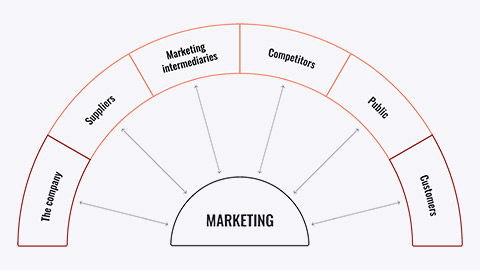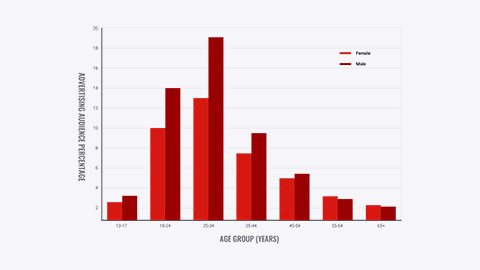Welcome to Marketing Environments. In this topic, you will learn about:
- Marketing environments
- Micro-environment
- Macro-environment
The marketing environments refers to many factors that influence a business and their relationship with their clients and consumers. Every business is affected by many factors and can never exist and operate “in a vacuum”, as it is an integral part of the business environment. Below are two main categories in marketing environments that show the different ways it impacts on a business. These are:
- Micro-environment: This influences the functionality of a particular business.
- Macro-environment: This affects the operation of all existing business entities out there.
Marketers have disciplined methods for collecting information about the marketing environment such as marketing research and marketing intelligence, although they spend most of their time in the customer and competitor environments.
Let us have a closer look at the two categories, paying close attention to their influencing factors and impact on a company.
The micro-environment is the environment that has a direct impact on the business and consists of all the factors affecting the business. It is related to the particular area the company operates and can directly affect all business processes. The image below is displaying six components to consider relating to each area of the company’s micro-environment.

Now let us read on about each of these factors of a company’s micro-environment.
The company’s micro-environment
The company
A company has various components to operate as a business, each of these components are branched into their own expertise that work together to build the companies efficiency.
These functional components are as follows:
- top management
- finance
- purchasing
- accounting
- operations
- research & development
Suppliers
Suppliers, being the stakeholder that supplies the product or service to the business has a significant pull on the business. For instance, if a supplier of a particular product is the largest, or even the only one, they are certainly going to have a big influence on how successful your business is. Suppliers are the ones who determine the price increase or decrease of their product and also obtain insurance that your business has the necessary resources to operate. Overall, the suppliers are an extremely important factor as they are the key link in the value delivery process. Most marketers today are aware of the importance of strong customer relationships and treat their suppliers as partners in creating and delivering customer value to ensure business success.
Marketing intermediaries
Marketing intermediaries are the businesses that provide a service that helps the company to promote, sell and distribute its products to final buyers.
The following are the types of marketing intermediaries:
- resellers are distribution channel firms that help the company find customers or make sales to them
- physical distribution firms help the company to stock and move goods from their points of origin to their destinations
- marketing services agencies are the marketing research firms, advertising agencies, media firms and marketing consulting firms that help the company to target and promote its products to the right markets
- financial intermediaries include banks, credit companies, insurance companies, accountants and other businesses that help finance transactions or manage the risks associated with the buying and selling of goods.
These marketing intermediaries can stimulate the overall business growth.
See the example below of a financial intermediary.

Accounting firms such as Nudge Accounting, which provides services to small-business owners, are among the many financial intermediaries that comprise the broader value network in which a business operates. Managing these relationships is also important.
Competitors
Every business that sells the same or a similar kind of product as you do are your competition in the market. Therefore, the competitor's sale and marketing tactics matter to you a great deal. This may mean you might need to adapt your own strategies to meet your business objectives. One strategy may be to see how a competitors’ product and its’ price affects yours and how you can make use of that in order to gain an edge over them, that is, provide greater value and have a point of difference than your competitors while still meeting the needs to your target consumers.
Publics
Publics are any group that has an actual or potential interest in or impact on an organisation’s ability to achieve its objective. They can be internal, local, general and financial and can also include media, government and citizens’ action groups
Every business organisation has in its best interest to appease to the general public. Every step that you take needs to be viewed from their perspective as well. It is extremely vital how your actions affect others because their opinion can be the one thing that either pushes you towards success or pulls you down from the pedestal.
The general public is highly important in terms of:
- public opinion
- media
- environmental pollution
Customers
Customers are the core of business micro-environment as they are who you are targeting and building a relationship with for the business product or service. The kind of customer base that your company attracts, as well as the reasoning behind purchasing your product, are going to highly affect the way you create marketing campaigns. Your customers can be B2C (consumer markets), B2B (business markets), international, local or reseller markets and government markets.
Below are important key factors related to customers:
- stability of demand
- prospects of sale growth
- relative profitability
- intensity of competition
The macro-environment is more general and less specific as it is the environment from the economy itself. It influences how all business groups operate, perform, make decisions, and form strategies simultaneously. Macro-environments are constantly changing, and businesses have to continually adapt to these changes. It consists of external factors that the company may have no control over but are certainly affected by, and its effect is usually long-term. It is what, in economics, is known for as exogenous factors.
The image below is displaying the six areas to consider relating for a company’s macro-environment.

Let us read further on each of these major influences on a company’s macro-environment.
The company’s macro-environment
Demographic environment
A demographic environment consists of the characteristics of the surrounding populations’ which can affect markets considerably. The study of human populations is referred to as demography and includes the following influencing factors:
- population size, density and diversity
- location and geographic population shifts
- age, gender, family size and structure
- educational characteristics and occupation
- race and ethnicity
- other relevant demographic statistics
In summary, each and every market is affected by the global demographic factors. Therefor it is of value to analyse and consider these characteristics when gathering an idea of your market.
Changing age structure of the population
Demographic cohorts of generations born of different time periods are categorised as follows:
Baby boomers are people born during the period following World War II, between 1946 and 1964.
- They make up 25% of Australia’s population
- But they have 53% of Australia’s wealth
Generation X are people born between 1965 and 1976, in the ‘birth dearth’ that followed the baby boom.
- They spend more money online each month than any other generation.
Millennials (Generation Y) are the children of baby boomers, born between 1977 and 2000.
- They are the largest generation in Australia.
- They are the first generation to grow up with digital technology
Generation Z are people born after 2000 (although many analysts include people born after 1995) who make up the children’s, tweens’ and teens’ markets.
- They easily blend online and offline worlds.
Have a look at the data below of Facebook's share of their advertising audience in 2020, categorised into age groups and gender. This provides the marketing team (as well as other stakeholders) insights into who their audience is- is it who they were aiming to target? It also allows them to get a deeper understanding which will also support them in effective marketing as they are better able to identify their audience.

Generational marketing
Marketers need to be careful about ‘turning off’ one generation each time they craft a product or message that appeals effectively to another. Each generation spans decades of time and many socioeconomic levels. Therefore, marketers need to form more precise age-specific segments within each group. Be mindful, that defining people by their birthdates may be less effective than segmenting them by their lifestyle, life stage or the common values they seek in the products they buy.
The below image is a great example of marketing to a widespread demographic audience, this type of image may be used when appealing to a majority.

The changing family
Family structures have changed immensely over the years. There has been a significant rise of single-parent families and families with no children along with a decline in the overall household size and an increase in the number of working women. All these can be influencing factors to a business and the consumers attracted to it.
Geographic shifts in population
Australians are quite mobile people, with about 40% of all Australian residents moving every five years. The metropolitan areas have a faster pace of living, more commuting, higher incomes and a greater variety of goods and services that can be found in the small towns and rural communities that dot the country. There has been a gradual geographic shift of population from rural to metropolitan areas. Data shows that young and old alike, are moving to urban communities and to larger coastal towns. At the same time, greater numbers of older generations are moving to regional towns and the coast.
Education and professions
Over 40 per cent of the Australian population and 34 per cent of the New Zealand population have attended university. Individuals who achieve higher educational outcomes are often better off in a number of ways; importantly, their lifestyles are different, and they earn more. For instance, nearly 70% of Australians are employed in white-collar jobs, the rising number of educated professionals will in turn, affect not just what people buy but also how they buy and will increase the demand for quality products, books, magazines, travel, personal computers, tablet devices and internet services.
Increasing diversity

The populations in both Australia and New Zealand are very diverse, with nearly one in three people born overseas. The millennial and Gen Z generations are the most diverse in history: only 56% of the 87 million millennials in the country are white, as compared to 72% of the 76 million members of the baby boomer generation. (CNN Money) According to a 2015 McKinsey report, companies in the top quarter for racial/ethnic diversity are 35% more likely to surpass peers, while those in the same bracket for gender diversity are 15% more likely to do the same. (McKinsey,2015)
Each national group has specific wants and different buying habits. Many marketers of food, clothing, furniture and other products have targeted specially designed products and promotions to one or more of these groups.
Diversity goes beyond ethnic heritage. For example, many major companies have recently begun to explicitly target gay and lesbian consumers. One estimate puts the Australian buying power of lesbian, gay, bisexual, transgender and intersex people (LGBTI) at a massive $20 billion per annum.
Each niché group has specific needs and wants along with different buying habits, with this in mind, many marketers of food, clothing, furniture and other products have specially designed and targeted products and promotions to one or more of these groups.
Increasing diversity
The populations in both Australia and New Zealand are much more diverse, with nearly one in three people born overseas. The millennial and Gen Z generations are the most diverse in history: only 56% of the 87 million millennials in the country are white, as compared to 72% of the 76 million members of the baby boomer generation. (CNN Money) According to a 2015 McKinsey report, companies in the top quarter for racial/ethnic diversity are 35% more likely to surpass peers, while those in the same bracket for gender diversity are 15% more likely to do the same. (McKinsey,2015)
Each national group has specific wants and different buying habits. Many marketers of food, clothing, furniture and other products have targeted specially designed products and promotions to one or more of these groups.
Diversity goes beyond ethnic heritage. For example, many major companies have recently begun to explicitly target gay and lesbian consumers. One estimate puts the Australian buying power of lesbian, gay, bisexual, transgender and intersex people (LGBTI) at a massive $20 billion per annum.
Economic environment

The economic environment consists of factors that affect consumer purchasing power and spending patterns, therefor the environment of the economy itself, has the ability to influence two essential aspects of the company:
1. Your company’s levels of production
2. The decision-making process of your customers.
For example, changes in income would have an impact on customer purchases as well as influencing their decision behind purchasing. This is an important factor that marketers should pay attention to, both income distribution as well as to income levels to achieve their goal of effective marketing. Over the past several decades, the rich have grown richer, the middle class has shrunk and the poor have remained poor. This distribution of income has created a tiered market. Companies target markets accordingly.
Below are some examples of economic factors affecting business:
- interest rates
- exchange rates
- recession
- inflation
- taxes
- supply and demand
Natural environment
Every business must also take into account the planet and its resources. For instance, renewable resources such as forests and agricultural products versus non-renewable resources such as coal, minerals, oil, natural gas and nuclear energy as these are strongly related to production.
Natural and physical forces can be:
- climate change
- pollution
- weather
- availability of both non-renewable and renewable resources
- laws that regulate the environment
- survival of particular biological species
With these issues becoming ever more prevalent in our rapidly developing climate, environmental sustainability is a growing focus of many companies, a factor which is also important to its consumers. The topic of environmental sustainability is concerned with developing strategies and practices that create a world economy that the planet can support indefinitely.
Technological environment

Technological factors are related to skills and ability that are implemented into production, as well as all the materials and technology that a particular product or service requires requires in order to be produced. These factors are essential and can have a big impact on how well your business is running.
Some of the most common technological factors are:
- automation
- internet connectivity
- 3D technology
- speed/power of computer calculation
- engine performance and efficiency
- security in terms of cryptography
- wireless charging
The technological environment, a rapidly changing environment, can drive companies to innovate and create new technologies and products and market opportunities.
Political and social environment
A Political environment refers to the laws, government agencies and pressure groups that influence or limit various organisations and individuals within a given society. The market, as a result, develops according to the political and legal environment in various areas, which means that every business needs to be up to date with such legal factors worldwide in order to be able to make the right decisions.
This generally includes legal factors such as:
- copyright law
- employment law
- fraud law
- discrimination law
- health and safety law
- import/export law
In our ever evolving climate there is an increased emphasis on ethics and socially responsible actions. Written regulations cannot possibly cover all potential marketing abuses, and existing laws are often difficult to enforce. However, beyond written laws and regulations, businesses are also governed by social codes and rules of professional ethics, socially responsible behaviour. There are companies that encourage their managers to look beyond what the regulatory system allows and simply ‘do the right thing’. Having a sound grasp of the surrounding political and social is essential as almost every aspect of marketing involves ethics and social responsibility issues.
Ethical and socially responsible

There is an increased emphasis on ethics and socially responsible actions. Marketers and businesses use tactics such as ‘cause-related marketing’ to influence the macro-environment to exercise their social responsibility and build more positive images with many companies are now linking themselves to worthwhile causes.
Have a look at the following insightful articles to gain further knowledge on how companies implement ethical behaviour in their businesses.
Net Zero Momentum Tracker— a site developed along with Monash University where is it possible to track all Australian companies that have pledged to reduce carbon-emissions and ensure they follow through with their pledge:
The Negative Effects of Corporate Greenwashing — Sea Going Green- article which elaborates on negative effects of corporate greenwashing.
Cultural environment
The term cultural environment refers to institutions and other forces that affect a society’s basic values, perceptions, preferences and behaviours, let us take a look into these and consider their potential influence.
Core and secondary beliefs and values
Core beliefs and values are relatively resistant to change because they are passed on from parents to children and are reinforced by schools, churches, business and government. Whereas secondary beliefs and values, are more open to change and adapt easily. Although core values are fairly persistent, cultural swings do take place. Consider the impact of popular music groups, movie personalities and other celebrities on young people’s hairstyling and clothing norms. The main cultural values of a society are expressed in people’s views of themselves and others, as well as in their views of organisations, society, nature and the universe. Marketers want to predict such cultural shifts in order to spot new opportunities or threats.
People’s views of themselves
People vary in their emphasis on serving themselves versus serving others. People use products, brands and services as a means of self-expression and therfor typically, but not exclusively, buy products and services that match their views of themselves.
People’s views of others
People’s attitudes towards, and interactions with, others shift over time. New ways of interacting strongly affects how companies market their brands and communicate with customers.
People’s views of nature
People vary in their attitudes towards the natural world. Some feel ruled by it, others feel in harmony with it and still others seek to master it. A long-term trend has been people’s growing mastery over nature through technology and the belief that nature is bountiful. More recently, however, people have recognised that nature is finite and fragile, and that it can be destroyed or spoiled by human activities. This renewed love of things natural has created a market of consumers who seek out everything from natural, organic and nutritional products to fuel-efficient cars and alternative medicines.
Now that you have read through the macro-environment and its’ influences to the company, look at the below image which illustrate 5 predicted emerging patterns in the future of the underlying forces that encourage changes to the global market.
Shifting economic power
- E7 economies double the size of G7 by 2040
- 80% of middle class in emerging economies
- 75% faster growth in emerging economies
- Emerging economies 50% of global by 2025
Rapid urbanisation
- 1.5 million people move to cities every week
- 66% live in cities by 2050, up from 54% today
- 61% of global GDP created by 750 cities
Climate change and resource scarcity
- 59% increase in food demand by 2050
- Water crisis is #1 global risk, says WEF
- 48% think business should be a force for good
- $22tn social responsible investments today
Demographics and social change
- Global population towards 10bn by 2050
- 13% of us over 65 by 2030, from 8% today
- 90% of under 25s live in emerging economies
Technological breakthrough
- 90% of world data created in last 2 years
- 1 trillion objects connected by 2022
- 90% of stock trading now done by algorithm
- 66% of world is connected at any time
End of topic forums
There are forum activities for this topic. Select the ‘Forum’ at the end of your module (which can be found within your navigation menu) and follow the instructions for each question pertaining to 2 within the forum.
Watch the following video which provides more detail in regards to Greenwashing and Fiji Water's marketing campaign.
Read the following campaign which discusses The troubling evolution of corporate greenwashing released by the Guardian.
Watch these videos after reading The Guardian article:
- 1980s Chevron Commercial
- DuPont Conaco Double-Hulled Oil Tankers Seal Clapping Commercial
- Westinghouse Nuclear :30 Commercial HD June 2013
Further reading

